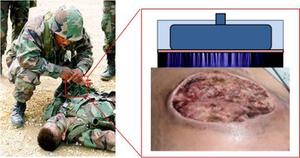Sterilizing waterIonized plasmas as cheap sterilizer in tough places
Scientists show that ionized plasmas like those in neon lights and plasma TVs not only can sterilize water, but make it antimicrobial; these plasma devices could be life-savers in developing countries, disaster areas, or on the battlefield where sterile water for medical use is in short supply and expensive to produce

DARPA applies plasma sterilization to combat wounds // Source: darpa.mil
University of California, Berkeley, scientists have shown that ionized plasmas like those in neon lights and plasma TVs not only can sterilize water, but make it antimicrobial — able to kill bacteria — for as long as a week after treatment.
Devices able to produce such plasmas are cheap, which means they could be life-savers in developing countries, disaster areas, or on the battlefield where sterile water for medical use — whether delivering babies or major surgery — is in short supply and expensive to produce.
“We know plasmas will kill bacteria in water, but there are so many other possible applications, such as sterilizing medical instruments or enhancing wound healing,” said chemical engineer David Graves, the Lam Research Distinguished Professor in Semiconductor Processing at UC Berkeley. “We could come up with a device to use in the home or in remote areas to replace bleach or surgical antibiotics.”
Low-temperature plasmas as disinfectants are “an extraordinary innovation with tremendous potential to improve health treatments in developing and disaster-stricken regions,” said Phillip Denny, chief administrative officer of UC Berkeley’s Blum Center for Developing Economies, which helped fund Graves’ research and has a mission of addressing the needs of the poor worldwide.
“One of the most difficult problems associated with medical facilities in low-resource countries is infection control,” added Graves. “It is estimated that infections in these countries are a factor of three-to-five times more widespread than in the developed world.”
A University of California, Berkeley release reports that Graves and his UC Berkeley colleagues published a paper in the November issue of the Journal of Physics D: Applied Physics, reporting that water treated with plasma killed essentially all the E. coli bacteria dumped in within a few hours of treatment and still killed 99.9 percent of bacteria added after it sat for seven days. Mutant strains of E. coli have caused outbreaks of intestinal upset and even death when they have contaminated meat, cheese and vegetables (also see this release from the American Institute of Physics).
Based on other experiments, Graves and colleagues at the University of Maryland in College Park reported 31 October at the annual meeting of the American Vacuum Society that plasma can also “kill” dangerous proteins and lipids — including prions, the infectious agents that cause mad cow disease — that standard sterilization processes leave behind.
In 2009 one of Graves’s collaborators from the Max Planck Institute for Extraterrestrial Physics
